After what proved to be a cracking weekend in Wales, I took a break from dragonflies and concentrated on butterflies for a couple of days, returning to dragonflies on Friday.
I took a little trip to the pond, a journey which proved more troublesome due to the sheer weight of holiday traffic heading west. A head-full of traffic jams, noise and endless diversions vanished halfway down the hill as the pond came into view. There’s a little rise where the pond appears on the horizon and you get a glimpse of what is – or not – flying.
Unfortunately there wasn’t anything large patrolling this side, but in the action corner a male Emperor reigned supreme over Common Darters, Broad-bodied and Four-spotted Chasers. The Damsels – Emerald, Common Blue, Blue-tailed and Azure, minded their own business below.
At the other end were more of the same plus a Keeled Skimmer, with the Blue-tailed seeming to prefer the muddy seepage leading down from the heath. Among the gorse & ferns were several more Common Darters, Broad-bodied Chasers and a male Migrant Hawker.
I positioned myself back at the (action) corner and watched the show as a female Emperor flew in to lay her eggs. At one point she was briefly whisked away by the male in a failed coupling before returning to her business.
Now & again the resident male from the other end would overstep his territory and a dogfight would ensue, a clash of wings as they rose high and separated back to their own patch.
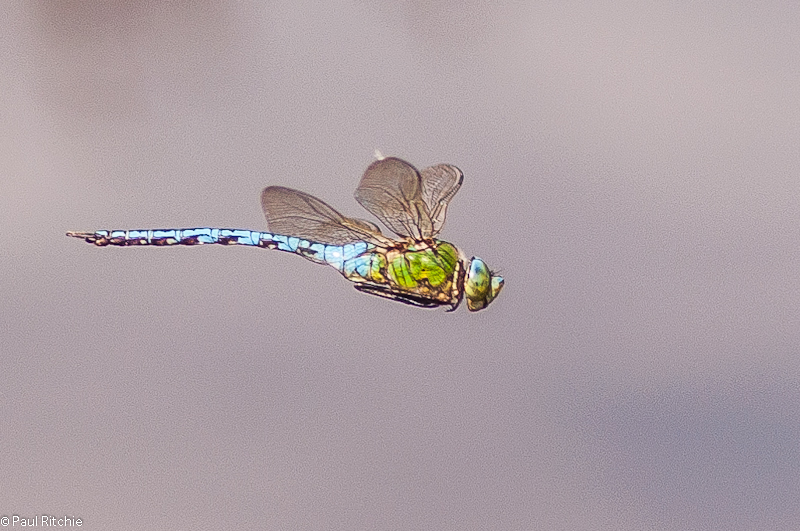
The water levels are looking healthy without being saturated, and the two smaller ponds – barely more than large puddles – have remained. The larger of these pools had almost as much action as the main pond, with a resident male Emperor, an ovipositing female, more Common Darters and Broad-bodied Chasers plus a lively population of damsels.
Satisfied I’d seen all I was going to see, I left a little too early, and having time to spare decided to look in on a small pond near Telegraph Hill. This pond appears be dependant on rainfall , being on the summit of the surrounding heath.
In the past this pond resembled nothing more than a large puddle lying next to a popular dog walk. Often used for a post-walkies bath or a venue for beer can boating in picnic season, I only ever visit on a weekday.
The water level was extremely high and appeared healthier with reeds and lillies providing a life force on what is a very odd shade of green- the type you normally find at disused quarries.
I at least hoped to find a Southern Hawker or two, as on previous occasions, but once again the ruling party was a male Emperor.
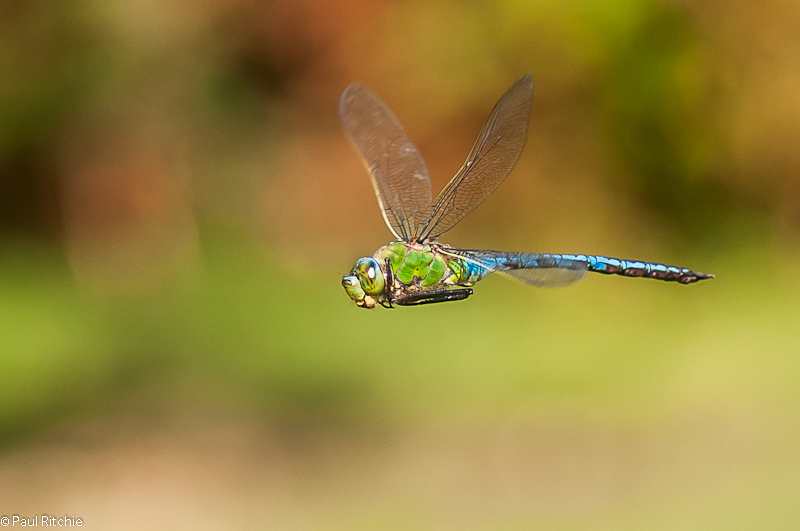
I watched as he appeared to enjoy the stiff breeze and, very much like a Kestrel, countering the wind perfectly while drifting sideways against the breeze, towards me, and then over the pond… returning in a pattern which was not entirely predictable.
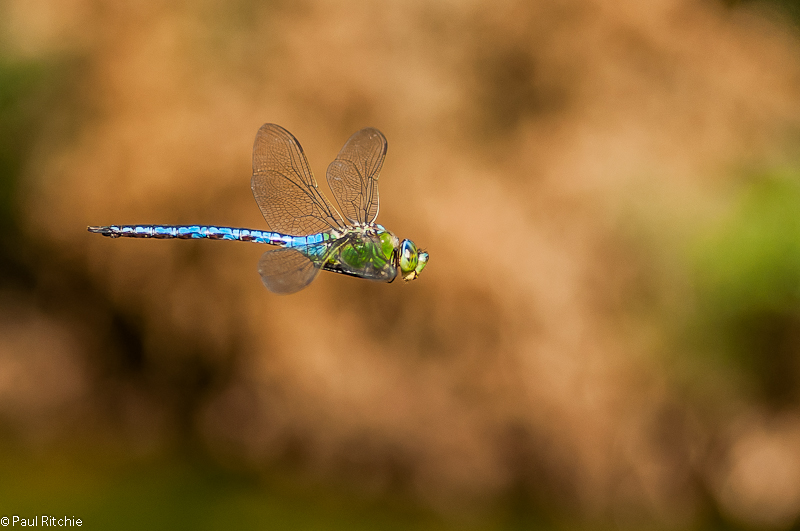
On a few occasions he would rise overhead, allowing a glimpse of the underneath. Interesting to see his head turned towards me while the thorax & abdomen remain perpendicular.

On Sunday Doug & I were guides for the DWT photography group on their annual dragonfly day. As the meeting time was 10.00am, I took advantage of the weather and had an early start to sneak in a Red-veined Darter or two before the main event.
I hadn’t realised they’d rebuilt the footpath until later, and used the gate entrance, traipsing through shoulder-high weeds and becoming saturated by dew before reaching the pools.
A male Emperor was already holding court while teneral Darters were rising from the reeds.

The majority were carried by the breeze across the lunar landscape, but one male stayed put long enough to get some shots in.
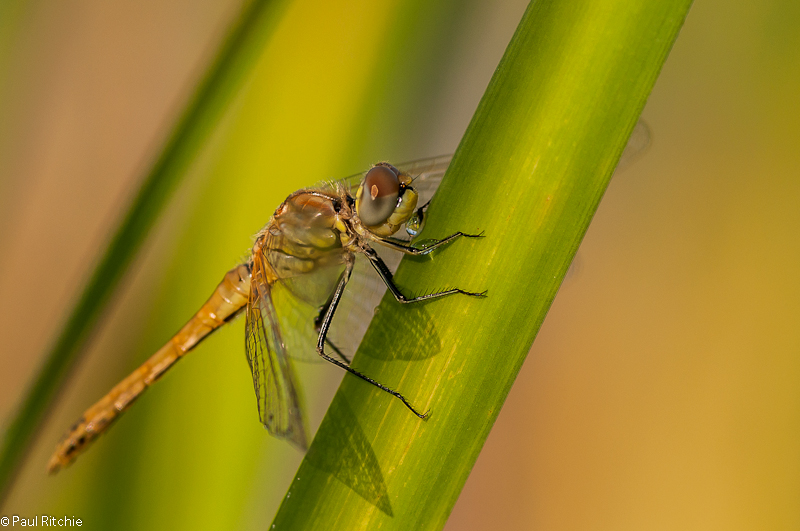
Satisfied, I explored the gorse bordering hawker alley, watching as hoards of Common Darters battled for popularity with Common Blue Damsels. A brief glimpse of a male Southern Hawker, and several more male Emperors rose before me having been disturbed by my passing.
Onwards to Ramsdown, a journey which took an hour due to the intolerable selfishness of ignorant cyclists, a recent New Forest menace. There was apparently a race on, and this gave the cyclists the mistaken belief that they had right of way.
Riding tyre to tyre and up to four abreast, they left no room for other road users to overtake, causing long and unnecessary tailbacks. Should you find a spot to overtake, you were met with jeers and gestures.
They also had no respect for the animals, cursing if their progress was cut short by a wandering pony. It will take a fatal accident for the powers that be to realise the influx of ignorant city-dwelling cyclist on summer weekends is an unacceptable danger to the harmony of the New Forest.
Back at Ramsdown we waited for the dozen or so photographers to arrive and led them up the track to the first pond. By now activity was positively buzzing, with another Emperor, Black & Common Darters, Four-spotted Chaser, Azure, Common Blue, Emerald and Small Red Damselflies across the water.
On two occasions a Grass Snake took to the water and swam to the far bank.
Along the margins I spotted a male Broad-bodied Chaser and someone else photographed a female Black-tailed Skimmer, while the skies would occasional light up with a passing Brown Hawker. I usually take a back step on these outings, but couldn’t resist the chance of a Black Darter mating wheel.
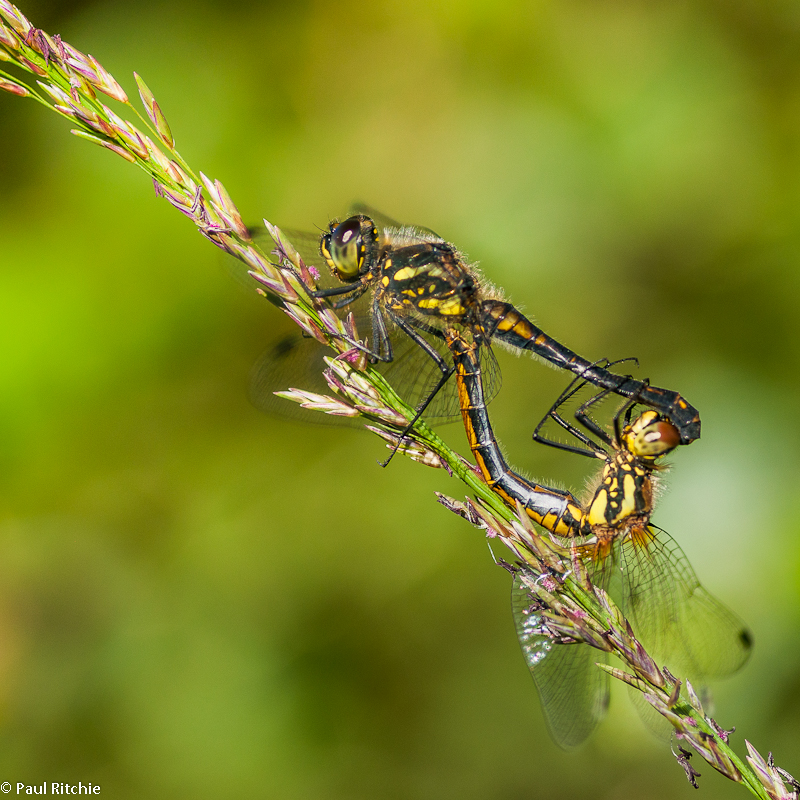
After the party had filled their boots at the pond, we made our way up and around the small hill hoping to flush out a hawker or two, but the heather revealed nothing today, except a very welcome sighting of a Smooth Snake.
Down the steep hill to the other pond where Black Darters ruled the roost with no less than a dozen pairs in tandem, along with more Emeralds and a few Common Blue.
From the treeline came a Brown Hawker, circling the pond several times before once again disappearing from view. Shortly after a male Southern Hawker appeared for a quick survey, and then a Common Hawker flew in and circled the pond a few times before flying off into the distance.
I did manage one record shot before he disappeared
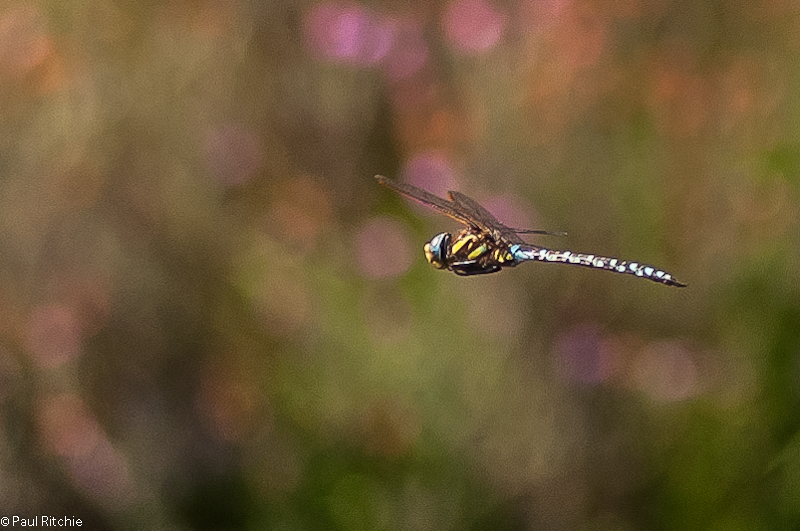
By now the heat had started to become a little uncomfortable and we all retreated to the car park for a lunch break before moving on to Troublefield. About half of the party remained and were rewarded with a couple of Golden-ringed, some Beautiful and Banded Demoiselles and a male and female Southern Hawker.

Our most surprising find was a male Emerald Damselfly, a first for this site. Obviously a refugee from Ramsdown. Let’s hope a female or two made the journey too!
No Migrants today, though still a fine day and a satisfying outing with a full daily count of 14 species.
